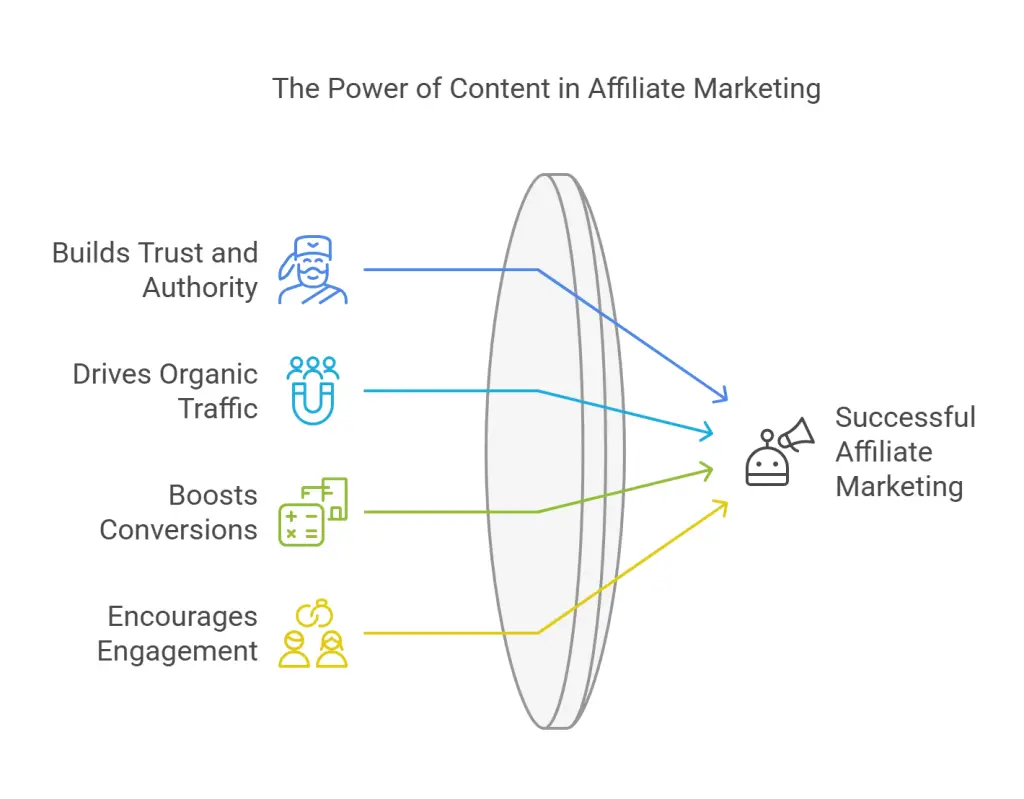Types of Content That Drive Affiliate Marketing Success
To maximize the impact of content in affiliate marketing, it’s essential to diversify your content strategy. Here are some of the most effective types of content you can create:
1. Blog Posts
In-depth articles like this one provide valuable information and naturally incorporate affiliate links. For example, a blog post titled “Top 10 Tools for Digital Marketers” can include affiliate links to each tool.
2. Product Reviews
Honest and detailed reviews help readers make informed purchasing decisions. A well-written review can highlight the pros and cons of a product, making it easier for your audience to choose.
3. Tutorials and How-To Guides
Step-by-step guides demonstrate how to use a product, making it more appealing. For instance, a tutorial on “How to Use Canva for Graphic Design” can include affiliate links to Canva’s premium plans.
4. Videos
Video content is highly engaging and can showcase products in action. Platforms like YouTube are perfect for creating product demos, unboxings, and reviews.
5. Email Newsletters
Regular emails keep your audience informed and engaged. You can include affiliate links in your newsletters, along with exclusive discounts or promotions.
6. Social Media Posts
Short, engaging posts on platforms like Instagram, Facebook, and Twitter can drive traffic to your affiliate links. Use eye-catching visuals and compelling captions to grab attention.
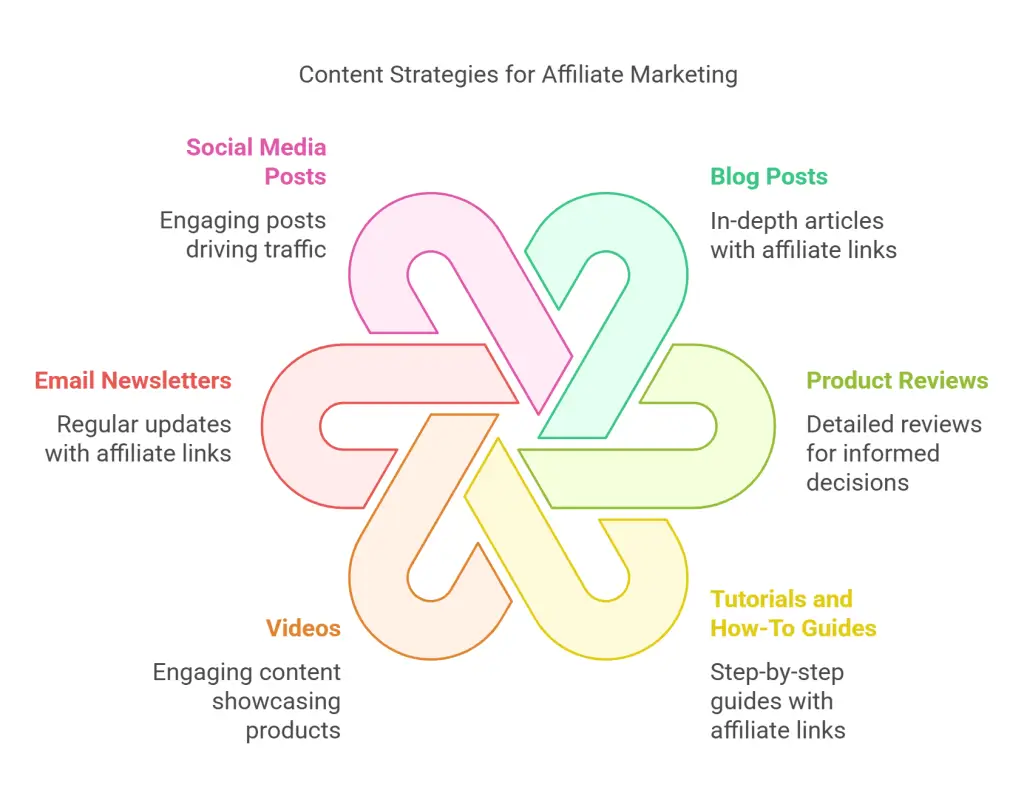
How to Create SEO-Optimized Content for Affiliate Marketing
Creating content that ranks well on search engines is crucial for affiliate marketing success. Here’s how to optimize your content in affiliate marketing for SEO:
1. Keyword Research
Use tools like RankMath, Ahrefs, or SEMrush to identify high-volume, low-competition keywords related to your niche. For example, if your niche is fitness, you might target keywords like “best home workout equipment” or “affordable fitness gear.”
2. On-Page SEO
- Title Tags: Include your focus keyword in the title. For example, “The Role of Content in Affiliate Marketing Success.”
- Meta Descriptions: Write compelling meta descriptions that include your keyword and encourage clicks.
- Headers (H1, H2, H3): Use headers to structure your content and include keywords naturally.
- URL Structure: Keep your URLs short and descriptive. For example, “clickscaptain.com/content-in-affiliate-marketing.”
3. Internal Linking
Link to other relevant pages on your website to improve navigation and SEO. For example, if you have a blog post about “How to Choose the Best Affiliate Products,” link to it from this article.
4. External Linking
Link to authoritative sources to boost credibility. For instance, if you’re discussing SEO best practices, link to a reputable source like Moz or HubSpot.
5. Mobile Optimization
Ensure your content is mobile-friendly, as most users browse on their phones. Use responsive design and test your website on different devices.
6. Page Speed
Use tools like Google PageSpeed Insights to improve loading times. A slow website can hurt your SEO rankings and user experience.
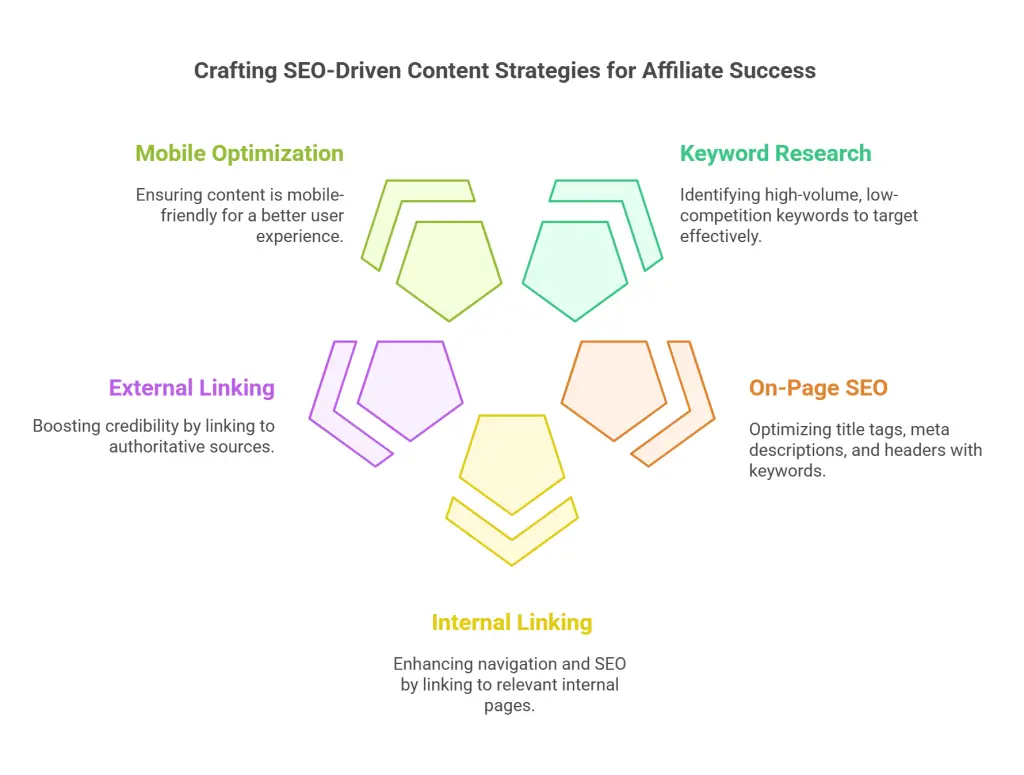
Actionable Tips for Writing High-Converting Affiliate Content
To make your content in affiliate marketing truly effective, follow these tips:
1. Know Your Audience
Understand their pain points, preferences, and buying behavior. Create buyer personas to tailor your content to their needs.
2. Focus on Quality Over Quantity
A single well-researched article can outperform dozens of low-quality posts. Invest time in creating valuable, in-depth content.
3. Use Persuasive Language
Highlight the benefits of the product and include strong calls-to-action (CTAs). For example, “Click here to get 20% off your first purchase!”
4. Leverage Visuals
Use images, infographics, and videos to make your content more engaging. Visual content is more likely to be shared on social media.
5. Be Transparent
Disclose affiliate relationships to build trust with your audience. For example, include a disclaimer like, “This post contains affiliate links, and I may earn a commission if you make a purchase.”
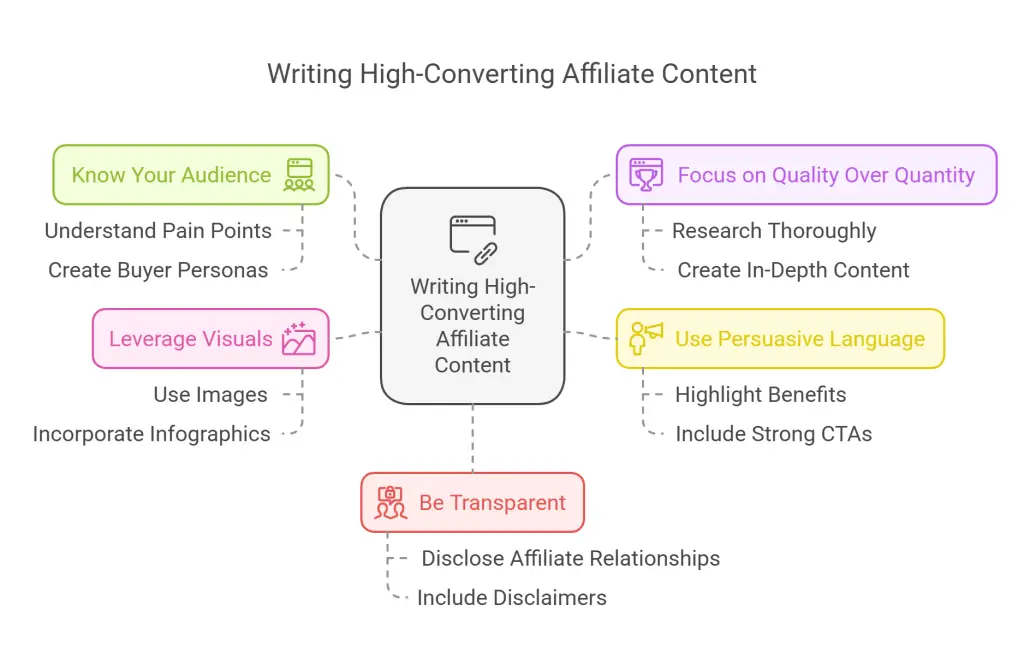
Common Mistakes to Avoid in Affiliate Marketing Content
Even the best strategies can fail if you make these common mistakes:
1. Overloading with Affiliate Links
Too many links can overwhelm readers and reduce credibility. Focus on adding value first, and include affiliate links naturally.
2. Ignoring SEO Best Practices
Poorly optimized content won’t rank well, no matter how good it is. Always follow SEO guidelines to maximize visibility.
3. Lack of Originality
Copying content from others can harm your reputation and SEO rankings. Always create original, unique content.
4. Neglecting Analytics
Regularly analyze your content’s performance to identify areas for improvement. Use tools like Google Analytics and RankMath to track metrics like traffic, bounce rate, and conversions.
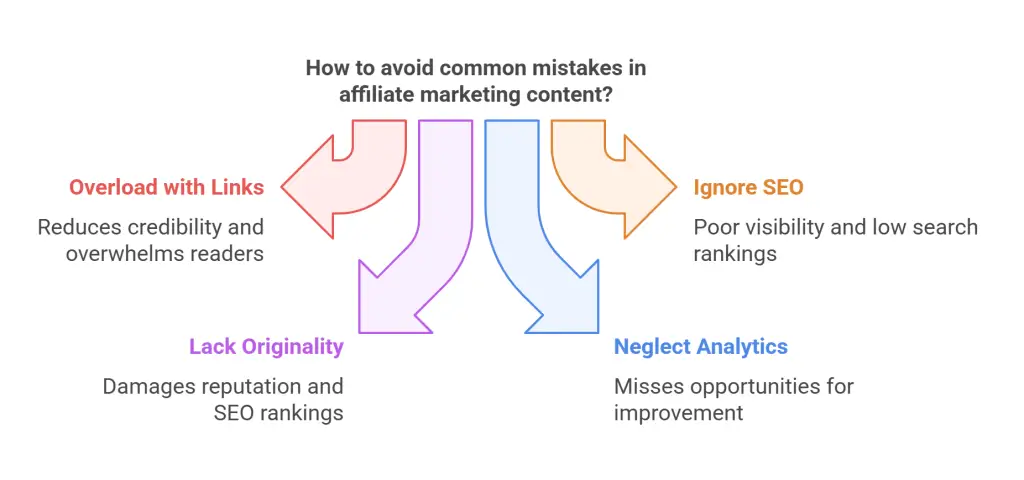
Advanced Strategies for Content in Affiliate Marketing
Once you’ve mastered the basics, it’s time to take your content in affiliate marketing to the next level. Here are some advanced strategies:
1. Create Evergreen Content
Evergreen content remains relevant over time, driving consistent traffic. Examples include “Beginner’s Guide to Affiliate Marketing” or “Top 10 Tools for Bloggers.”
2. Repurpose Content
Turn a single piece of content into multiple formats. For example, convert a blog post into a video, infographic, or podcast episode.
3. Collaborate with Influencers
Partner with influencers in your niche to reach a wider audience. They can promote your content and affiliate links to their followers.
4. Use A/B Testing
Test different headlines, CTAs, and layouts to see what works best. A/B testing can help you optimize your content for higher conversions.
5. Leverage User-Generated Content
Encourage your audience to share their experiences with your recommended products. User-generated content builds trust and authenticity.
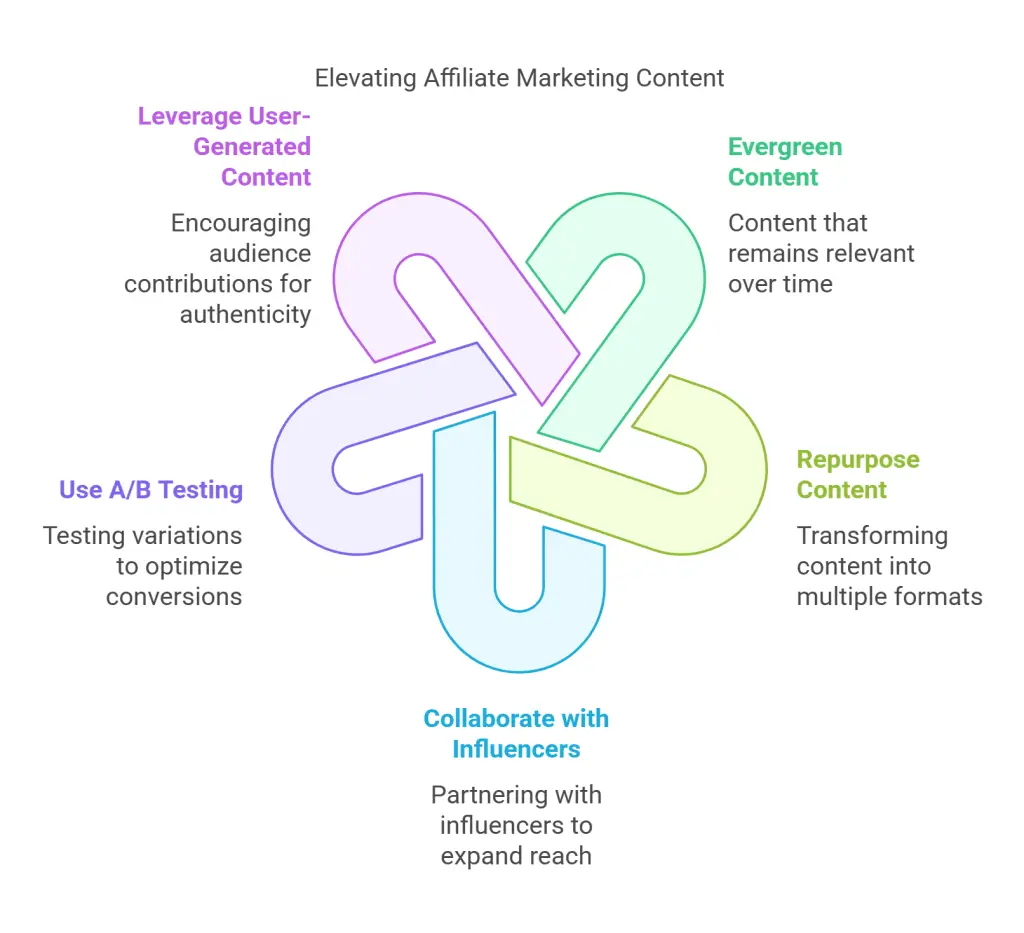
Case Study: How Content Transformed an Affiliate Marketing Business

Let’s look at an example of how content in affiliate marketing can drive success. Mike, a home improvement contractor, started his affiliate marketing journey by promoting tools and construction materials. Initially, he struggled to generate sales. However, after implementing a content-focused strategy, his revenue skyrocketed.
What Mike Did Differently:
- Created In-Depth Product Reviews: Mike wrote detailed reviews of the tools and materials he promoted, highlighting their features and benefits.
- Published How-To Guides: He created tutorials on how to use the products effectively, such as “How to Build a Deck Using Composite Materials.”
- Leveraged SEO: Mike optimized his content for search engines, targeting keywords like “best power tools for DIY projects.”
- Engaged with His Audience: He responded to comments and questions, building a loyal community of DIY enthusiasts and professionals.
Within six months, Mike’s affiliate income increased by 300%. This case study demonstrates the power of content in affiliate marketing.
Tools to Create and Optimize Affiliate Marketing Content
To streamline your content creation process, here are some tools you can use:
1. RankMath
A powerful SEO plugin for WordPress that helps you optimize your content for search engines.
2. Canva
A graphic design tool for creating eye-catching visuals, such as infographics and social media posts.
3. Grammarly
A writing assistant that helps you eliminate errors and improve the quality of your content.
4. SEMrush
An all-in-one SEO tool for keyword research, competitor analysis, and content optimization.
5. Google Analytics
A free tool for tracking your website’s performance and analyzing user behavior.
Conclusion: Mastering Content in Affiliate Marketing
The role of content in affiliate marketing success is undeniable. In a competitive digital landscape, content bridges your audience and the products you promote. High-quality, optimized content drives traffic, builds trust, nurtures relationships, and boosts conversions. By focusing on content, you can establish yourself as a trusted authority and achieve long-term success.
One key advantage of content is its ability to create sustainable traffic. Unlike paid ads, which stop working when you stop spending, SEO-optimized content continues to attract visitors over time. Evergreen content like guides, tutorials, and reviews can generate traffic months or even years later, making it a cost-effective, long-term investment.
Content also builds trust by addressing audience pain points and providing genuine value. When your audience trusts you, they’re more likely to follow your recommendations and click affiliate links. This trust is the foundation of successful affiliate marketing.
Moreover, content is versatile. It can take many forms—blog posts, videos, social media updates, or email newsletters—allowing you to reach your audience wherever they are. Diversifying your content strategy maximizes reach and engagement.
However, creating effective content requires ongoing effort. Regularly analyze performance using tools like Google Analytics and RankMath. Identify what works, optimize it, and experiment with new formats and strategies to stay ahead in the ever-evolving digital landscape.
Ultimately, content in affiliate marketing is about providing value. When your audience gains knowledge, entertainment, or solutions, they trust you more, creating a win-win situation. By prioritizing quality, SEO, and audience needs, you can create content that drives results and sets you apart. Great content is the key to unlocking affiliate marketing success.
Frequently Asked Questions
What role does content play in affiliate marketing?
What types of content work best for affiliate marketing?
Why is high-quality content important in affiliate marketing?
How does SEO impact affiliate marketing content?
How can engaging content increase affiliate conversions?
Further reading
BigCommerce. “What Is Affiliate Marketing? How to Start & Succeed.” BigCommerce, last modified March 11, 2025. https://www.bigcommerce.com.au/articles/ecommerce/affiliate-marketing/. (Accessed March 11, 2025).
Adam Enfroy. “Affiliate Marketing for Beginners in 2024 (Step by Step).” YouTube, uploaded January 10, 2024. https://www.youtube.com/watch?v=SLm9lJnBvyo. (Accessed March 11, 2025).
HubSpot Marketing. “What Is Affiliate Marketing & How to Start Earning Money.” YouTube, uploaded June 12, 2023. https://www.youtube.com/watch?v=wqMtnX5Zq04. (Accessed March 11, 2025).
Social Snowball. “How to Create High-Converting Affiliate Marketing Content.” Social Snowball Blog, last modified March 11, 2025. https://www.socialsnowball.io/post/affiliate-marketing-content. (Accessed March 11, 2025).
Project Life Mastery. “How to Start Affiliate Marketing for Beginners.” YouTube, uploaded October 3, 2022. https://www.youtube.com/watch?v=lD8zh2aG4Ig. (Accessed March 11, 2025).


